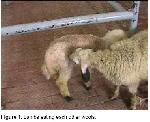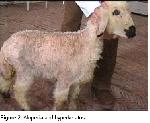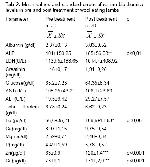It is suggested that faulty feeding and trace element deficiencies cause wool eating in lambs, sheep and goats, leading to considerable economic losses
3,7,11,14. Clinical signs of wool eating, such as alopecia, parakeratosis, hair loss, growth failure, stiff gait and diarrhoea were also determined in our study. Similar clinical findings were observed by other authors
6,15 in natural wool eating in sheep and goat. Nelson et al
9 reported that sheep fed experimentally with rations poor in zinc quickly cause alopecia or brittle wool after seventeen days of the experiment. Furthermore, Suliman et al
10 found severe alopecia and wool eating syndrome in sheep with zinc deficiency. Clinical findings we obtained from wool eating lambs are compatible with those of the researchers. In the study, RBC, WBC values of lambs with the wool eating habit were not significantly different when the values obtained from pre and post treatment were compared. However PCV (p<0.05) and haemoglobin(p<0.001) values of the diseased animals were significantly different in terms of pre and post treatment. Nelson et al
9 found that haematological values were at normal levels in wool eating lambs and goats. Suliman et al
10 reported that haemoglobin and haemotocrit values were statistically diferent before and after treatment in zinc deficiency lambs with wool eating habits. In this study, WBC, RBC values were similiar to those reported by some researchers
7,9. At the same time, haemoglobin and haemotocrit values were also the same as those of Suliman et al
10
Suliman et al10 reported that serum globulin, total protein ALP, zinc, copper levels decreased, but LDH levels elevated and albumin level was normal in wool eating sheep and lambs. Ott et al5 found that blood changes typically in serum zinc and albumin levels decreased and globulin levels with wool eating lambs increased. The researchers reported that serum ALP and Mg, Fe, values were at normal ranges while zinc and cooper levels were low in wool eating lambs and goats.
Huang youde et al6,15 reported that serum sulfur and copper levels decreased, whereas serum Ca, P, Fe, Mn, Zn, Co, Mo, and Se levels were at normal levels in their research on wool eating sheep and goats in China. The findings of this study have shown that the values we obtained were parallel to the decrease of the value of Cu but different with Zn, Ca, Fe values.
Akgül et al7 reported that serum iron, manganese, phosphorus, calcium, sodium and chloride values of diseased sheep were not significantly different from the control animals. On the other hand, serum zinc and copper values of the diseased animals were significantly lower than the controls. Furthermore, total protein levels of the diseased sheep were significantly different from the control group. On the contrary, glucose, albumin and AST values were not significantly different. ALP and GGT levels increased significantly in the diseased sheep compared to the normal animals .
In current study decrease in serum Zn, Cu, Ca, Fe levels was consistetent with the other researhcers. Suliman et al10 found decrease in serum Zn level, while no change in Cu level in wool eating lambs. Our findings were parallel to the Zn level but were not compatible with Cu levels. Although Akgül et al7 did not find any significant changes in Ca and Fe levels, we observed significant changes in Ca and Fe levels. We suppose that it is due to stable feeding.
In the present study, albumin, glucose, AST, ALP were consistent with those reported by Akgül et al7, while total proteins were not the same. The values mentioned above were not parallel to those of Suliman et al10. The difference of ALP value is thought to be high in young and rickety lambs.
Based on this study, it is believed that wool eating syndrome in lambs is the result of reduced zinc, copper and other trace elements values. Similarly, some researchers6,9,10 suggest that sheep, lambs and goats fed for a long time with certain rations that are poor in zinc, copper, sulfur and trace elements develop deficiency syndromes .
The researhers12,16 gave 40mg of zinc sulfate in a capsule orally each day for 10 to 14 days to severely affected rams. Also, the ewes were given capsules of zinc carbonate orally several times weekly. Clinical status of the affected animals improved rapidly with zinc supplementation. In our study, smiliar findings were seen 4 weeks after treatment and entire recovery at 8 weeks.
Conclusion
We conclude that trace element deficiency may cause wool eating and considerable economic losses. It is thought that Zn, Cu and Fe must be added to the diet of lambs with wool eating complaint. We also, suggest that more comphrehensive studies are required.






